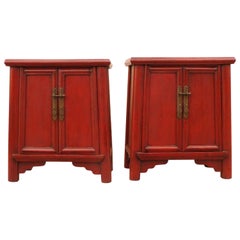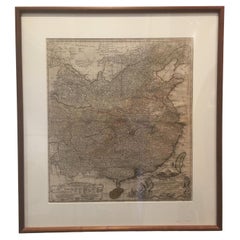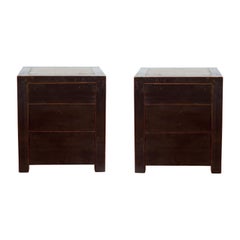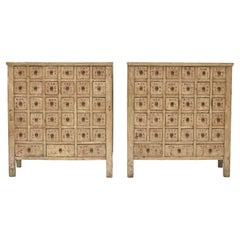Greenwich Oriental Antiques More Furniture and Collectibles
to
1
2
2
1
1
1
1
1
1
1
1
1
1
2
2
2
Pair of Red Lacquer Chests
Located in Greenwich, CT
Pair of red lacquer chests with open doors and removable shelf inside on each chest, one drawer inside each chest.
Category
Vintage 1920s Chinese Ming Furniture
Materials
Wood
$3,840 Sale Price / set
20% Off
Framed Map of China
Located in Greenwich, CT
Map of China, 19th century. European print map of China
Conservation frame with walnut frame
Overall dimension : 28 1/2" wide 31" high 2" depth with fra...
Category
Antique 19th Century European Qing Prints
Materials
Paper
$3,800
Related Items
Pair of Black Lacquer Nightstands Tables with Antique Stone Inset Tops
Located in Yonkers, NY
Quietly refined and full of contrast, this pair of Chinese black lacquered bedside cabinets offers a thoughtful blend of 20th-century design and ancient material history. The clean, ...
Category
20th Century Chinese Night Stands
Materials
Stone
$3,600 / set
H 28 in W 24.75 in D 19.75 in
Pair of Yellow lacquered Apothecary Medicine Chests
Located in Kastrup, DK
Pair of Chinese apothecary / pharmacy medicine chests. Made of elm wood with ivory lacquer.
Each with 33 drawers (30 small square drawers + 3 larger ).
These were used to store and o...
Category
Antique Early 19th Century Chinese Qing Commodes and Chests of Drawers
Materials
Elm
Antique Japanese Erotic Shunga Woodblock Print of a Couple in Gilt Frame
Located in Yonkers, NY
An antique Japanese Shunga woodblock print in gilt frame depicting a man and a woman making love. Created in Japan, this woodblock print called...
Category
Antique 19th Century Japanese Prints
Materials
Glass, Wood
$1,200
H 16.5 in W 13.5 in D 1 in
Chinese Red Lacquer Canopy Bed with Footrest, c. 1900
Located in Chicago, IL
A Chinese canopy bed, or marriage bed, was the most important part of a bride's dowry and was the central feature of her personal quarters. Traditionally, beds were central to Chines...
Category
Antique Late 19th Century Chinese Qing Furniture
Materials
Elm, Reed
Pair of Matching Red Lacquered Bedside Tables / Cabinets with Drawers
Located in Reading, Berkshire
Pair of 20th century Chinese Red Lacquered Bedside Tables with Drawers Finished With Exquisite Figural Decorative Scenes
Extra dimensions
Drawer height 5cm
Doored cabinet heig...
Category
Mid-20th Century Chinese Chinese Export Furniture
Materials
Brass
$4,020 / set
H 24.02 in W 15.95 in D 12.6 in
Antique Framed Japanese Shunga Woodblock Print of Two Women Making Love
Located in Yonkers, NY
An antique Japanese Shunga woodblock print in gilt frame depicting two women making love. Created in Japan, this woodblock print called a Shung...
Category
Antique 19th Century Japanese Prints
Materials
Glass, Wood, Paint
$1,200
H 13 in W 15.5 in D 1 in
Framed Japanese 19th Century Woodblock Print of Kabuki Actors Toyokuni III
Located in London, GB
Japanese 19th Century Woodblock Print of Kabuki Actors Toyokuni III
Original Woodcut by Toyokuni III (1786 - 1864)
Of the Kabuki actors Bando Hikosab...
Category
Antique 19th Century Japanese Prints
Materials
Paper
$1,907
H 13.39 in W 9.06 in D 0.79 in
Pair of Chinese Red Lacquered Console Tables
Located in Stamford, CT
A pair of Chinese red lacquered console tables from the 1940s.
Category
Mid-20th Century Chinese Furniture
Materials
Wood
Pair of Red Lacquered Cube Side Tables with Ming Dynasty Marble Tops
Located in Yonkers, NY
A pair of Chinese elmwood cube shaped side tables from the late 20th century made with antique red lacquered elmwood and possibly Ming Dynasty period marble inset tops coming from a ...
Category
Late 20th Century Chinese Mid-Century Modern Side Tables
Materials
Marble
$8,800 / set
H 24 in W 28 in D 28 in
Antique Chinese Printed Ink Rubbing of Panthaka Arhat, (scroll mounted)
Located in Point Richmond, CA
Chinese ink rubbing printing depicting Panthaka Arhat, no.4 of the 16 arhat images immortalized in stone at the former stupa at Shengyin Temple. Depicted here sitting on a rock with a book in his left hand and snapping his fingers in his right hand, symbolic of the speed at which he obtained enlightenment, accompanied by a beggar’s bowl and an incense burner, complete with colophons and silk scroll mounting. The Emperor Qianlong ordered the stone stele to be carved in 1764 after the arhat designs painted by the famed artist Guanxiu (832-912). Even though the temple was destroyed in the Taiping rebellion, the steles remain and have been reinstalled at the Hangzhou Stele Forest. Condition: Creases from rolling, otherwise fine condition. Mounting: 58” x 22”. 19th Century. Ex Collection: Frank “Till” & Peggy Durdin, San Diego.
For other rubbings of this stele see:
Penn Museum, object number 2010-26-4
The Metropolitan Museum of Art AN#: 59.195.15
Fine Arts Library of Harvard University, record id: W280021_urn-3:FHCL:478850
For another example of this image rendered in jade and lacquer see: “Screen Paintings of Guanxiu’s Sixteen Arhats in the Collection of the Palace Museum” Luo Wehhua translated by Bruce Doar, Orientations, September 2010, p. 104. In this article the image is identified as the sixteenth arhat Abheda, It is explained in this article that Qianlong re-identified the arhats, thus the 16th Arhat attribution for this image. Also in this article the identical colophon by Qianlong above the image is translated as: “These accurate portraits of the Sixteen Arhats were created by the Tang Dynasty painter Guanxiu, as recorded in Xuanhe Huapu (Record of paintings in the Xuanhe Reign), and during the millennium from the Guangming reign period to the present day, the original works were to be found in Zhejiang, where they were housed in the collection of Shengyin Temple in Qiantang (Huangzhou). In spring of the dingchou year (1757) of his reign, the Qianlong emperor undertook a southern tour of inspection and stayed at an imperial lodge on the West Lake. He went to the temple to pay his respects and there he saw the arhats on display and wrote a description of these marvels. The sequence of the arhats and their names had been passed down since ancient times, but they did not correspond to their Sanskrit titles; the sequence of the arhat names conformed instead to the interpretation of the Sanskrit classics by the Zhangjia State Preceptor. The emperor penned the original names and positions in the sequence below each of the figures in accordance with the readings supplied in Tongwen Yuntong (Unified Rhymes), and below each he penned an encomium, which he signed. Then the images were returned to the collection, to be passed down as a perpetual treasure. Now, the fourth great arhat had long gone missing and we did not know where his painting was. But it was merely a trifling matter of matching the images with the names, and now surely we have found him! This I, the emperor, believe.”
All 16 of these rubbings can be found in the Rubel Chinese Rubbings Collection at the Fine Arts Library of Harvard University with the following descriptive historical note: “Rubbing from stele depicting No. 4 of 16 arhats (Lohans, Buddhist saints) -- Nan ti mi duo luo qing you, Panthaka Arhat. Original painting attributed to Guanxiu, 832-912. Inscriptions written by Hongli, Emperor Qianlong (Gaozong, 1711-1799) of Qing Dynasty. 7 seals of Qianlong follow the inscriptions. Script style: in xing shu. Shi liu zun zhe -- "The 16 noble ones" are 16 lohans. Lohans are also called "a-lo-han" based on the transliteration of the Sanskrit term "arhat." (Japanese: Rakan; Chinese: Lohan; Tibetan: Gnas-brtan). Arhats or Arahants are saints or sages said to have renounced nirvana (freedom from the cycle of suffering and rebirth), vowed to remain in the world to protect the Dharma and propagate the Law of the Buddha in order to devote themselves more effectively to the relief of human misery, like the Bodhisattvas. These 16 Arhats, personal disciples distinguished by the Buddha, formed part of the 500 claimed by tradition to have attended the First Council in Rajagrha. The names and abodes of these 16 arhats are given in a work entitled "Record on the Duration of the Law, spoken by the Great arhat Nadimitra," which was translated into Chinese by the famous pilgrim Xuanzang (596-664) in 654. 16 lohans are quite often represented, especially in China and Japan, in sculpture and painting, in poses and with attributes. Every lohan can be easily with special icongraphic characteristics. Guanxiu (Jiang Deyin or Deyuan, a Buddhist monk also named Master Chan Yue, 832-912) -- painter during late Tang to Five Dynasties, specialized in painting lohan figures. Legend has it that the first portraits of the 18 Lohans...
Category
Antique 19th Century Chinese Qing Prints
Materials
Paper
Antique Framed Japanese Shunga Woodblock Print of a Man and a Woman Making Love
Located in Yonkers, NY
An antique Japanese Shunga woodblock print in gilt frame depicting a man and a woman making love. Created in Japan, this woodblock print called...
Category
Antique 19th Century Japanese Prints
Materials
Glass, Wood, Paint
$1,200
H 16.5 in W 13.5 in D 1 in
Set of 3 Japanese framed woodblock prints by Utagawa Toyokuni, 1786-1865
Located in Kenilworth, IL
Japanese woodblock triptych by Utagawa Toyokuni printed on rice paper in the Ukiyo-e style. Theses richly patterned images are of Kabuki theater actors....
Category
Antique 19th Century Japanese Prints
Materials
Paper
$2,200 / set
H 22.75 in W 18.63 in D 0.75 in



